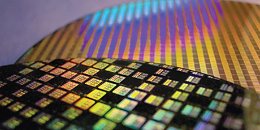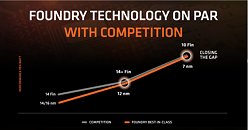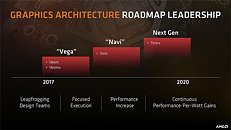Tuesday, August 28th 2018

AMD Chip Manufacturing to Lay Solely With TSMC On, After 7 nm - And Why It's not a Decision, but a Necessity
It's been a tumultuous few days for AMD, as the company has seen Jim Anderson, Computing and Graphics Group leader after the departure of Raja Koduri, leave the company, at a time of soaring share value for the company (hitting $25.26 and leaving short positions well, short, by $2.67 billion.) However, there's one particular piece of news that is most relevant for the company: Globalfoundries' announcement to stop all ongoing development on the 7 nm node.
This is particularly important for a variety of reasons. The most important one is this: Globalfoundries' inability to execute on the 7 nm node leaves AMD fully free to procure chips and technology from competing foundries. If you remember, AMD's spin-off of GlobalFoundries left the former with the short end of the stick, having to cater to GlobalFoundries' special pricing, and paying for the privilege of accessing other foundries' inventories. Of course, the Wafer Supply Agreement (WSA) that is in place will have to be amended - again - but the fact is this: AMD wants 7 nm products, and GlobalFoundries can't provide.To the forumites: this piece is marked as an editorial
AMD's CTO Mark Papermaster wrote thus in a blog post:
Should anything befall TSMC, should the silicon giant trip, AMD will have all of its product portfolio endangered. Consumer and professional GPU and CPU products will all be manufactured under TSMC's 7 nm process, as AMD has stated time and again - and in quite an aggressive manner. Here's hoping other players step up to the 7 nm manufacturing task, or, that being as hard as it is, that nothing affects TSMC's ability to deliver, lest one giant brings down others with it.
Sources:
AMD Blogs, via TechSpot
This is particularly important for a variety of reasons. The most important one is this: Globalfoundries' inability to execute on the 7 nm node leaves AMD fully free to procure chips and technology from competing foundries. If you remember, AMD's spin-off of GlobalFoundries left the former with the short end of the stick, having to cater to GlobalFoundries' special pricing, and paying for the privilege of accessing other foundries' inventories. Of course, the Wafer Supply Agreement (WSA) that is in place will have to be amended - again - but the fact is this: AMD wants 7 nm products, and GlobalFoundries can't provide.To the forumites: this piece is marked as an editorial
AMD's CTO Mark Papermaster wrote thus in a blog post:
AMD's next major milestone is the introduction of our upcoming 7nm product portfolio, including the initial products with our second generation "Zen 2" CPU core and our new "Navi" GPU architecture. We have already taped out multiple 7nm products at TSMC, including our first 7nm GPU planned to launch later this year and our first 7nm server CPU that we plan to launch in 2019. Our work with TSMC on their 7nm node has gone very well and we have seen excellent results from early silicon. To streamline our development and align our investments closely with each of our foundry partner's investments, today we are announcing we intend to focus the breadth of our 7nm product portfolio on TSMC's industry-leading 7nm process.The thing is, AMD going solely with TSMC for 7 nm isn't a decision: it's a necessity. It's a necessity of increasing need for AMD to bank on its powerful forward momentum against Intel on the CPU wars. It's essential for AMD's continued push in the professional, server field. And it's of utmost importance for AMD's relevance in graphics technologies against NVIDIA's frankly dominating position (despite AMD controlling all high-performance games consoles, a strategy that will only increase its fruits for AMD, should they be able to maintain this exclusivity - and all points towards that). Zen 2, EPYC 2, Vega 20, Navi - those are not only sizeable pieces of AMD's product portfolio, these are its bread and butter.As great as that part of the deal is for AMD, there's an obvious drawback of yet another foundry being left in the dust of new node developments: the weight of the world's semiconductor manufacturing capability on the 7 nm node - and AMD's efforts in it - stand solely on the shoulders of one player. And that's not even looking into actual output for TSMC's 7 nm node, how many customers will want to manufacture their chips on it, and whether or not TSMC has the ability to satisfy demand from all players.
Should anything befall TSMC, should the silicon giant trip, AMD will have all of its product portfolio endangered. Consumer and professional GPU and CPU products will all be manufactured under TSMC's 7 nm process, as AMD has stated time and again - and in quite an aggressive manner. Here's hoping other players step up to the 7 nm manufacturing task, or, that being as hard as it is, that nothing affects TSMC's ability to deliver, lest one giant brings down others with it.






87 Comments on AMD Chip Manufacturing to Lay Solely With TSMC On, After 7 nm - And Why It's not a Decision, but a Necessity
It's pretty obvious AMD knew this was coming so they already were planning on TSMC all along.
I'm more concerned that TSMC doesn't have the manufacturing capacity to handle AMD CPUs on top of everything else they have to manufacture. AMD demands millions of processors to be delivered every year that, up until now, was always handled by itself or Global Foundries. Can TSMC handle it or are back orders going to soar?
America has practically nothing techwise anymore. My state alone used to rule too (Motorola, TI, AMD, etc).
A foundry can always take orders from less relevant chip-designers and somehow continue to live on their previous node. But if - like Intel - they rely only on their own foundry, then if either foundry OR the chip design isn't up to speed both suffer. That's how it turned out with Intel - foundry can't deliver 10nm for which Intel was designing for, and they can't just go redesign for TSMC process - one thing that redesigning would cost, another that their foundry's credibility would plummet.
On the other hand, GF can just continue produce some custom chips, smartphone chips and so on, and they'll be all right even without AMD. AMD can just go to TSMC and get stuff made there.
There is no need to continue use crazy amounts of cash for R&D. GF just proves that by dropping their R&D for the time being, they decided they can continue profit on 12/14nm for several years longer. By then, EUV tech will be more available and the cost of R&D will decrease, they will be able to get on it again.
But for now, we might be looking at the last "good" node shrink, if not ~14nm was the last good one…
The theory that a company will be more profitable and manageable by concentrating on design and development and ditching it's manufacturing is but a way of justifying sending factories to Asia.
Lies, we're surrounded by lies and useful idiots that propagate them.
www.nytimes.com/2017/02/08/technology/trump-intel-chip-factory-arizona.html Hmm, another reason for me to go AMD.
12/14/16 are the ~the same.
So what gap are they closing. Intel 10nm is said to be 100 mtr per mm2 - 3x density of intel 14nm, and that is much denser than tsmc 16nm.
It means VEGA64 on 7nm is 4x density integrated video APU size chip or 484mm2/4=121mm2.
The way I see it 7nm VEGA 64 is RX 660 121mm2 sized chip with single HBM2 running on 1.2Ghz or 300GB/s.
And what have they done VEGA20 on 7nm is 325mm2 same count of 4096 cores as VEGA64.
Overbloated with some 200mm2 unknowns or are AMD trying to make us believe they have 7nm tsmc when in reality is just 10nm with 2x density.
The maximum density doesn't mean everything will be scaled with same factor. Some parts, like cache can be dense, hotter parts will be hardly denser at all.
newsroom.intel.com/editorials/fab-42-recent-announcement/